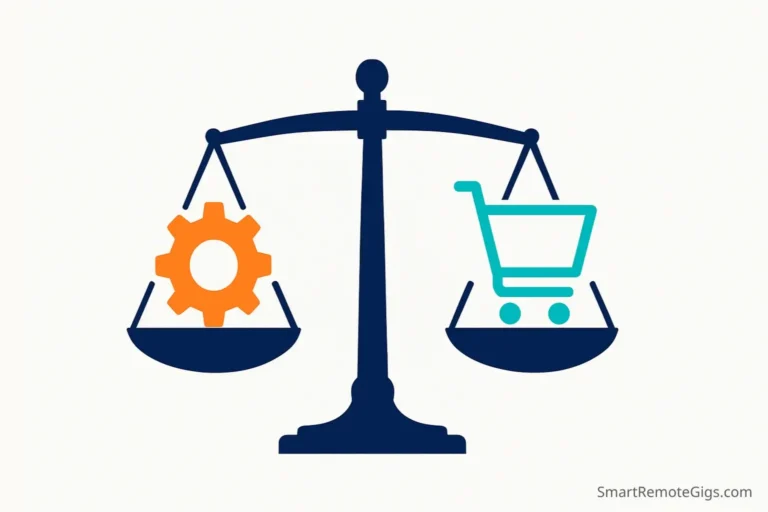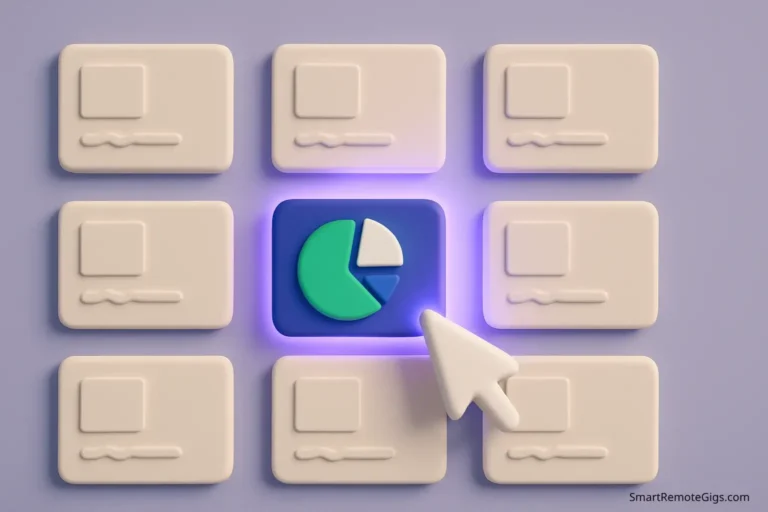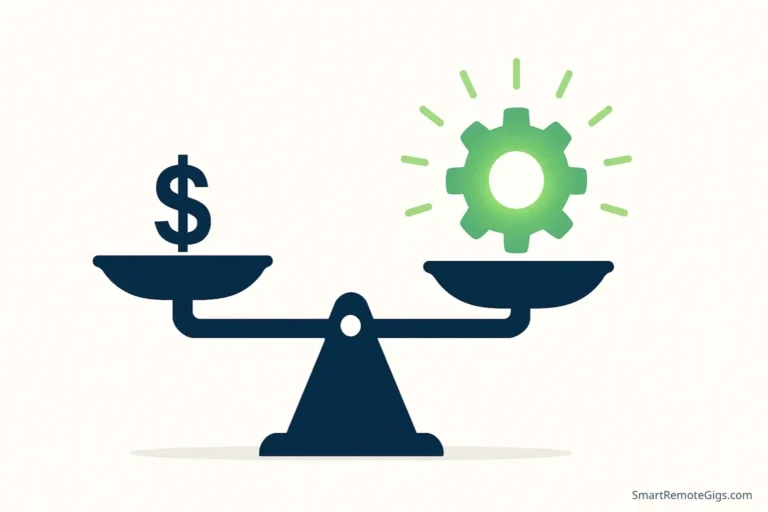You’re running a business—your freelance career—but here’s the brutal truth: when you stop working, your income stops flowing. This is the classic “time-for-money trap” that keeps talented freelancers stuck in an endless cycle of client hunting, project delivery, and financial uncertainty.
The feast-or-famine cycle is real. One month you’re drowning in projects, the next you’re scrambling to pay bills. The constant pressure to find the “next client” leads to burnout, and despite your skills and expertise, you’re always just one lost client away from financial stress.
But what if there was a systematic way to transform your active freelancing skills into automated revenue streams? Enter the Freelancer’s Passive Income Flywheel—a proven framework that doesn’t require you to abandon client work, but rather builds sustainable wealth alongside it. This isn’t about get-rich-quick schemes or “effortless money.” It’s about strategically packaging your expertise into income streams that work while you sleep.
Setting the Stage: What Is “True” Passive Income for a Freelancer?
Let’s destroy the myth right now: there’s no such thing as “no-effort money.” Anyone selling you that dream is likely trying to separate you from your hard-earned cash.
True passive income for freelancers is income that requires a significant upfront investment of time and skill, but then continues to generate revenue with minimal ongoing maintenance. Think of it like planting a fruit tree—you invest time, energy, and resources upfront, but once it’s established, it produces fruit season after season with just basic care.
This definition builds realistic expectations. You’re not looking for magic; you’re looking for leverage. The goal isn’t to replace your freelance income overnight, but to create multiple income streams that reduce your dependence on active client work and provide financial security.
When we talk about passive income ideas for freelancers, we’re discussing systems that can generate money while you’re working on client projects, sleeping, or taking a much-needed vacation.
Introducing The Freelancer’s Passive Income Flywheel
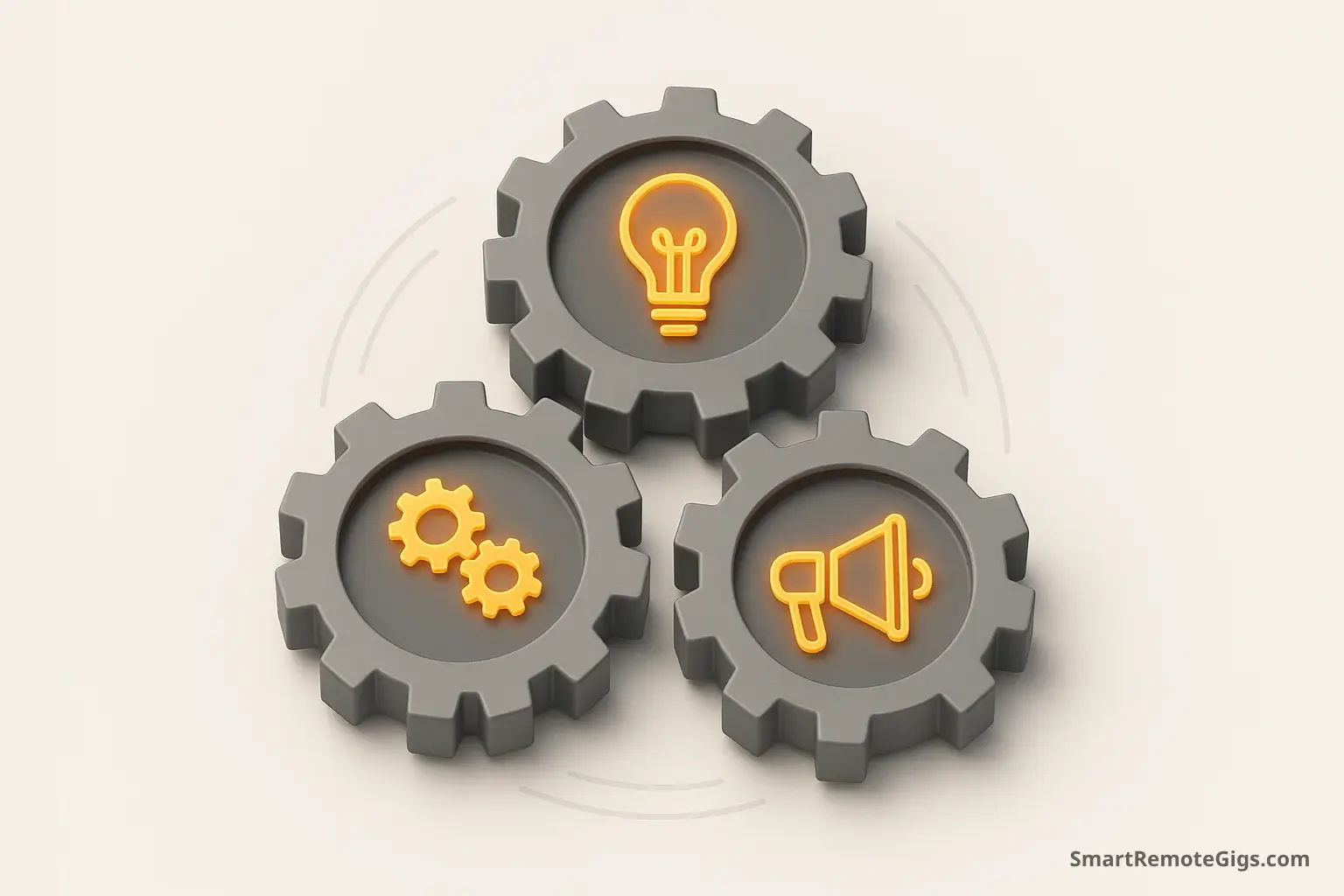
The secret to building sustainable passive income as a freelancer lies in understanding the three progressive stages of wealth creation:
- Stage 1: Leverage Your SKILLS (Package what you already know and do)
- Stage 2: Leverage Your AUDIENCE (Monetize the platform you build)
- Stage 3: Leverage Your SYSTEMS (Scale with automation and capital)
This flywheel approach ensures you’re not jumping randomly between passive income strategies. Instead, you’re building systematically, with each stage supporting and amplifying the next. Most freelancers fail at building passive income because they skip stages or try to do everything at once.
The beauty of this framework is that it starts with what you already have—your existing skills and expertise—rather than requiring you to learn entirely new domains.
Stage 1: Leverage Your SKILLS (Package Your Expertise)
This stage is where most freelancers should start because it leverages your existing expertise and requires the least additional skill development. You’re essentially productizing what you already do for clients.

Idea #1: Sell High-Value Digital Templates
- Best For: Designers, Writers, Consultants, Virtual Assistants
- Effort Level: Medium
- Income Potential: Medium to High
- Your First Action Step: Identify the #1 document, design, or deliverable you create for every client and turn it into a reusable template.
Digital products represent one of the most accessible paths to automated revenue streams for freelancers. Every client project you complete contains elements that other businesses need. That proposal template you’ve perfected? That contract you’ve refined through dozens of projects? Those design assets you create repeatedly? They’re goldmines waiting to be packaged.
The key to successful template creation is specificity. Instead of creating a generic “business proposal template,” create a “SaaS Startup Pitch Deck Template for Series A Funding” or a “Local Restaurant Social Media Content Calendar.” The more specific and targeted your template, the higher price you can command and the easier it becomes to market. This specificity principle also applies to pricing your freelance services – specialized expertise commands premium rates.
Platforms like Etsy, Creative Market, and Gumroad make it simple to start selling digital products without building your own e-commerce infrastructure. Many freelancers report earning $500-$3,000 monthly from well-designed template collections.

Idea #2: Write and Sell a Niche E-book or Guide
- Best For: Writers, Consultants, Coaches, Marketing Specialists
- Effort Level: High
- Income Potential: Medium to High
- Your First Action Step: List the top 3 questions clients ask you repeatedly, then choose the most valuable one to address in a comprehensive guide.
An e-book isn’t just a longer blog post—it’s a comprehensive solution to a specific, high-value problem your target audience faces. The most successful freelancer e-books solve problems that clients pay hundreds or thousands of dollars for you to address in person.
For example, if you’re a freelance marketing consultant who specializes in helping local businesses improve their online presence, you might write “The Local Business Owner’s Complete Guide to Google My Business Optimization.” This addresses a specific pain point with actionable, step-by-step guidance.
The easiest passive income for writers often comes from packaging their expertise into formats that clients can consume independently. Self-publishing platforms like Amazon KDP, Gumroad, or your own website can distribute your e-book globally.
Price your e-book based on the value it provides, not the time it took to write. If your guidance can save a business owner $10,000 in advertising costs, a $97 e-book is a bargain. Understanding value-based pricing is crucial for all freelancers – the same principles that apply to pricing your freelance services apply to your digital products.
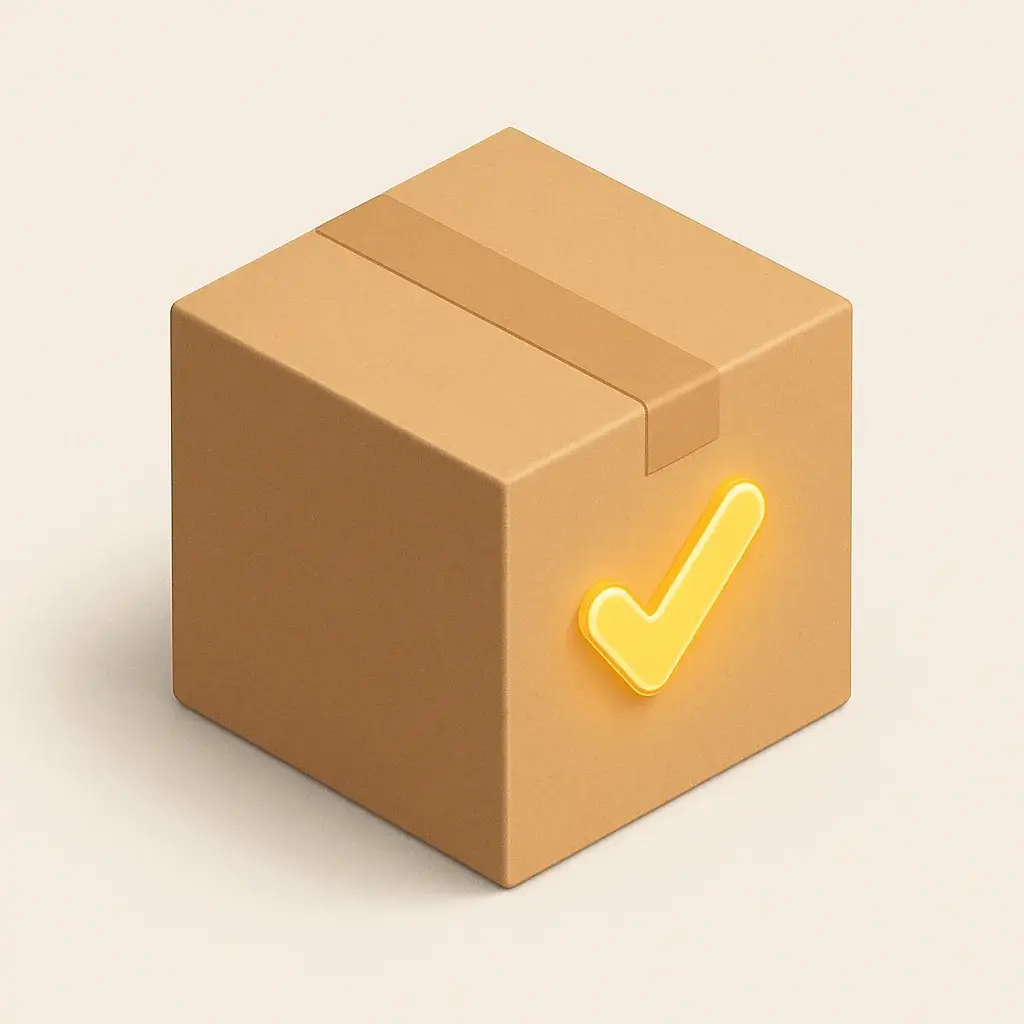
Idea #3: Offer a “Productized” Service
- Best For: All freelancer types
- Effort Level: Low to Medium
- Income Potential: High
- Your First Action Step: Take your most popular service and define exactly what’s included, what’s not included, and set a fixed price and timeline.
A productized service bridges the gap between custom freelance work and fully passive income. It’s a standardized, fixed-scope offering that you can deliver efficiently because you’ve refined the process through repetition.
Examples include:
- “48-Hour Logo Design Package” for $497
- “Website SEO Audit Report” delivered in 3 business days for $297
- “Social Media Content Calendar” (30 posts) for $197
The magic of productized services is predictability. Clients know exactly what they’re getting and when they’ll get it. You know exactly how long it takes and how much you’ll earn. But the success of a productized service hinges on one critical factor: setting a profitable fixed price. This isn’t just about guessing; it’s about understanding your costs, the market, and the immense value you provide. To master this, you need a solid framework.
For a step-by-step method, read our complete guide: Freelance Pricing Formula: A Guide to Setting Your Rates. This approach is the foundation for turning any service into a profitable, scalable product.
Stage 2: Leverage Your AUDIENCE (Build and Monetize Your Platform)
Once you’ve successfully packaged your skills into products or services, the next stage involves building an audience around your expertise. This stage requires more upfront effort but offers greater scalability and higher income potential.

Idea #4: Affiliate Marketing for Tools You Genuinely Use
- Best For: All freelancer types with online presence
- Effort Level: Low
- Income Potential: Medium
- Your First Action Step: Make a list of 5 tools you genuinely use and love, then research their affiliate programs.
Freelancer passive income through affiliate marketing works best when you promote tools and services you actually use in your business. Your audience trusts your recommendations because they know you understand their challenges.
Instead of promoting random products for higher commissions, focus on the software, tools, and services that genuinely make your freelance life easier. If you’re a graphic designer, you might promote your favorite design software, stock photo subscriptions, or project management tools through your blog, social media, or email newsletter.
If you’re looking to upgrade your own operational toolkit, we’ve tested and ranked the 7 Best Project Management Tools for Freelancers (2025).
The key to successful affiliate marketing is education, not promotion. Create content that teaches your audience how to solve problems, and naturally incorporate affiliate links to tools that support your solutions. A tutorial on “How to Create Professional Client Proposals” that mentions your preferred proposal software performs better than a direct sales pitch.
Many freelancers earn $200-$2,000 monthly through affiliate marketing by consistently creating helpful content and naturally recommending tools they use.

Idea #5: Create a Paid Premium Newsletter
- Best For: Writers, Consultants, Industry Experts
- Effort Level: Medium
- Income Potential: High
- Your First Action Step: Choose one specific niche topic you could write about weekly, then start a free newsletter to test interest.
Email newsletters represent one of the most reliable methods to build passive income as a freelancer because they create direct relationships with your audience. Platforms like Substack and Ghost make it easy to monetize newsletter content through paid subscriptions. Follow our expert guide, How to Start an Email Newsletter: A 7-Step Freelancer Guide, to get your newsletter live in as little as one week.
The most successful freelancer newsletters provide industry insights, curated resources, or educational content that busy professionals value but don’t have time to research themselves. For example, a freelance marketing consultant might create a weekly newsletter analyzing successful marketing campaigns, while a freelance developer could share coding tutorials and industry trends.
Pricing typically ranges from $5-$50 monthly, depending on the value and frequency of content. Even with a modest subscriber base of 200 paying subscribers at $10/month, you’re generating $2,000 in monthly recurring revenue.
The beauty of newsletter income is its predictability and growth potential. Unlike project-based income, newsletter subscriptions compound over time. To maintain consistency with your newsletter schedule, consider implementing effective time management strategies that help you balance content creation with client work.
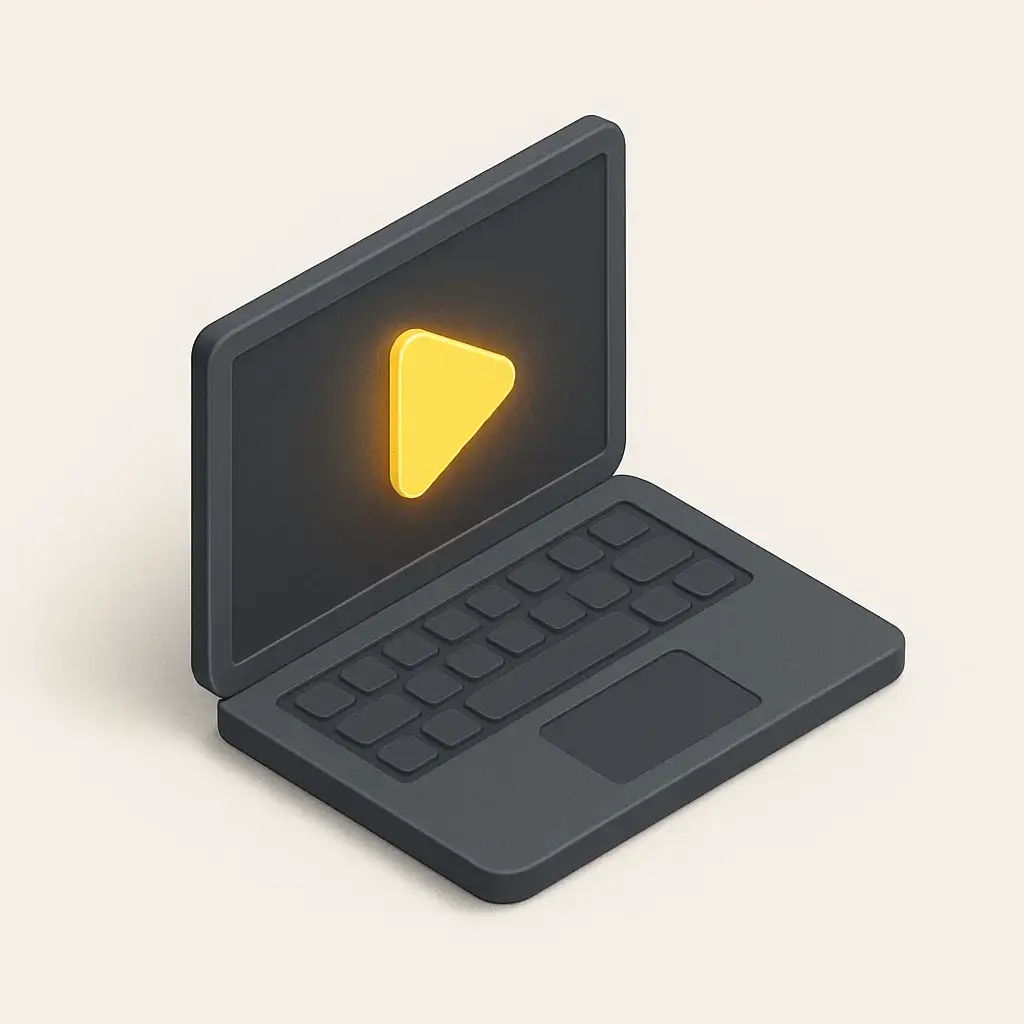
Idea #6: Launch a Niche Online Course or Workshop
- Best For: All freelancer types with teachable skills
- Effort Level: High
- Income Potential: High
- Your First Action Step: Identify one specific skill you could teach in a 2-hour workshop, then create an outline with 5-7 key learning objectives.
Online courses represent the highest income potential in Stage 2 because they package your expertise into scalable educational products. The key word is “niche”—broad courses face intense competition, while specific courses can command premium prices.
Instead of creating “How to Freelance,” create “How to Land Your First $5,000 Web Design Client in 60 Days” or “The Complete Guide to Freelance Copywriting for SaaS Companies.” Specificity attracts the right audience and justifies higher prices.
Platforms like Teachable, Thinkific, and Podia provide the infrastructure to host and sell your courses. Many successful freelancers price their courses between $197-$997, depending on the depth and transformation promised.
The upfront effort is significant—expect to invest 40-100 hours creating a quality course—but successful courses can generate income for years with minimal maintenance.

Idea #7: Start a Niche YouTube Channel or Blog
- Best For: All freelancer types comfortable with content creation
- Effort Level: High
- Income Potential: Medium to High
- Your First Action Step: Choose a specific niche within your expertise and commit to publishing one piece of content weekly for 6 months.
Content creation through blogging or YouTube builds long-term passive income through advertising revenue, affiliate marketing, and audience building for other products and services. The key to success is consistency and niche focus.
Passive income for designers might come from YouTube tutorials about specific design techniques, monetized through ads and affiliate links to design tools. A freelance writer might build a blog sharing writing tips and industry insights, monetized through affiliate marketing and lead generation for writing services.
YouTube Partner Program and Google AdSense provide direct monetization, while the audience you build becomes the foundation for promoting your other products and services. Many freelancers report earning $500-$5,000 monthly from established content channels.
Success requires patience—most channels need 6-12 months of consistent content creation before generating meaningful revenue, but the long-term potential makes it worthwhile for freelancers committed to content creation.
Stage 3: Leverage Your SYSTEMS (Automate and Scale Your Income)
Stage 3 represents the most advanced passive income strategies, requiring either significant technical skills or capital investment. These approaches offer the highest scalability but aren’t suitable for every freelancer.

Idea #8: Build a Micro-SaaS or Niche Tool
- Best For: Developers, Technical Freelancers, or those willing to learn/outsource development
- Effort Level: High
- Income Potential: Very High
- Your First Action Step: Identify one small, repetitive task in your industry that could be automated with simple software.
Micro-SaaS represents the pinnacle of how to make passive income as a freelancer because it creates recurring revenue through software subscriptions. Unlike traditional SaaS companies that require millions in funding, micro-SaaS focuses on solving small, specific problems for niche markets.
Examples include:
- A simple invoice tracking tool for freelancers
- A social media hashtag generator for specific industries
- A client onboarding checklist tool for consultants
The key is starting small and solving one specific problem extremely well. Many successful micro-SaaS products generate $1,000-$10,000+ monthly recurring revenue with minimal ongoing maintenance once established.
If you’re not technical, you can outsource development through platforms like Upwork or partner with a developer who shares your vision.
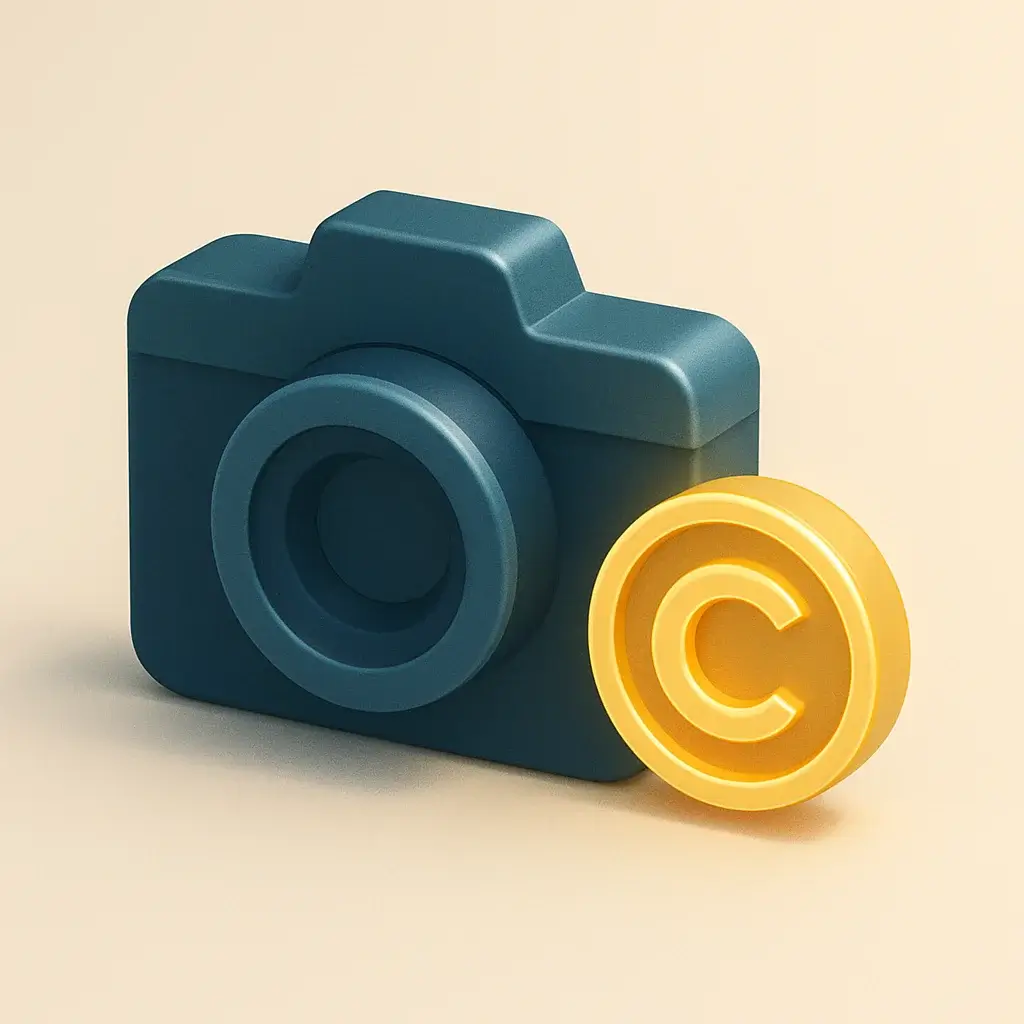
Idea #9: License Your Creative Assets
- Best For: Designers, Photographers, Writers, Video Editors
- Effort Level: Medium
- Income Potential: Medium
- Your First Action Step: Review your past client work and identify 10 assets you could modify and license (remove client-specific elements).
Stock photography, video clips, music, illustrations, and written content generate ongoing royalties through licensing platforms. Every creative asset you’ve produced for clients contains elements that could be repurposed for broader licensing.
Platforms like Shutterstock, Adobe Stock, Getty Images, and specialized sites for your medium provide global distribution. While individual asset earnings might be small, a portfolio of hundreds or thousands of assets can generate meaningful monthly income.
The key is volume and quality. Successful stock contributors upload new content regularly and focus on trending topics and commercial applications.

Idea #10: Invest Freelance Profits
- Best For: All freelancers with excess income to invest
- Effort Level: Low
- Income Potential: Medium to High (long-term)
- Your First Action Step: Open a brokerage account and commit to investing a fixed percentage of each client payment.
This strategy is often overlooked but crucial for long-term financial freedom. Investing your freelance profits in dividend stocks, index funds, or REITs creates true passive income through market returns and dividends.
The key is consistency rather than timing the market. Many financial advisors recommend the “pay yourself first” approach—automatically investing 10-20% of each client payment before other expenses.
Platforms like Vanguard, Fidelity, and Charles Schwab offer low-cost index funds that provide broad market exposure with minimal fees. For those interested in real estate investment without property management, REITs (Real Estate Investment Trusts) offer dividend income and potential appreciation.
Editor’s Pick: The 3 Easiest Passive Income Streams to Start Now
1. Digital Templates: Package your existing work into reusable templates. Low barrier to entry, immediate income potential.
2. Affiliate Marketing: Promote tools you already use through your existing content and client relationships. Requires no additional product creation.
3. Productized Service: Standardize your most popular service offering with fixed scope and pricing. Bridges active and passive income perfectly.
These three strategies require minimal new skill development and can generate income within 30-90 days of implementation.
How to Choose Your First Passive Income Project
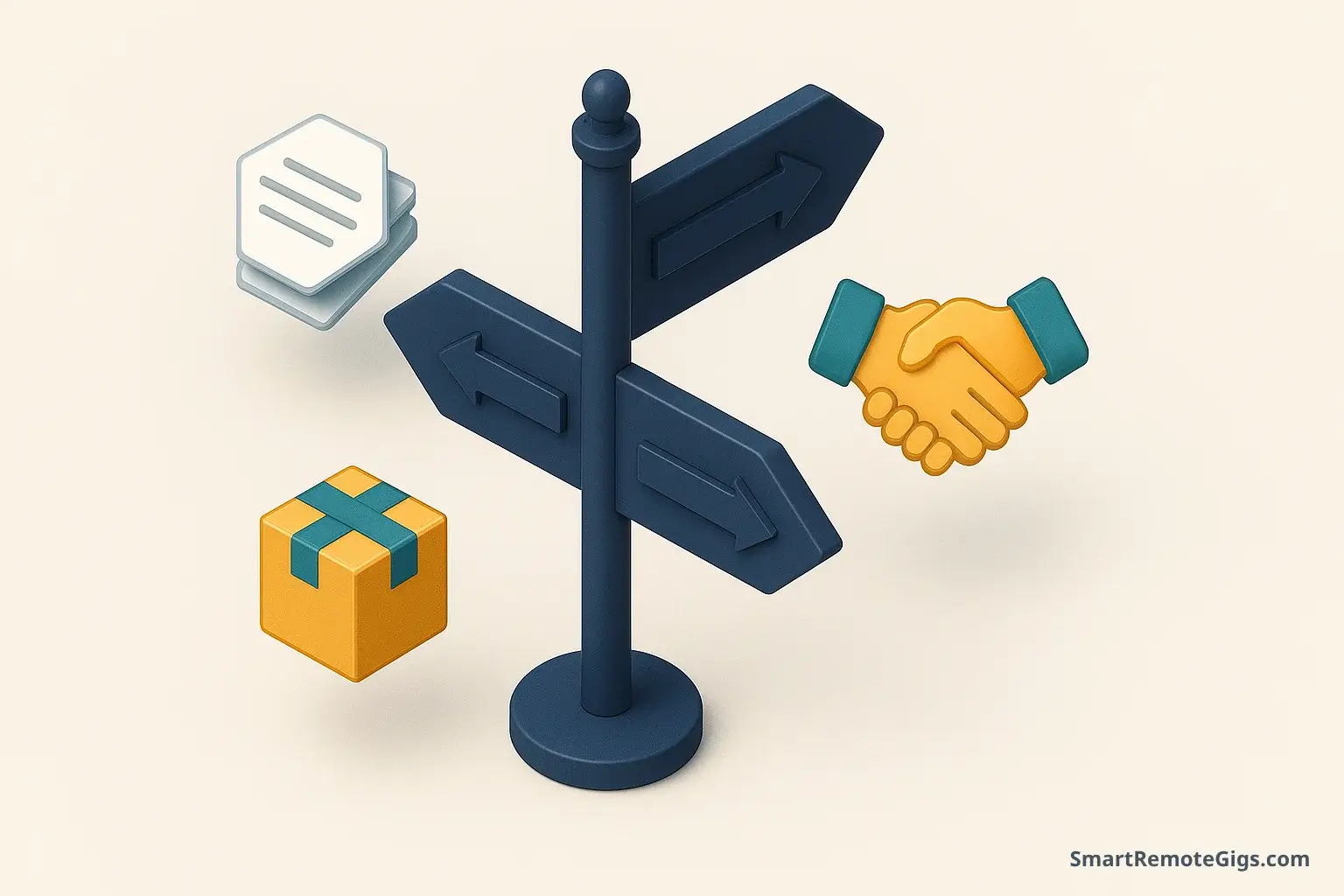
Not every passive income strategy suits every freelancer. Use these questions to identify your best starting point:
| Question | Consider This |
|---|---|
| What skills do you already have? | Start with Stage 1 strategies that leverage existing expertise |
| How much time can you commit upfront? | Templates and affiliate marketing require less time than courses or SaaS |
| Do you prefer writing, video, or design? | Match your content preference to your strategy |
| What problem can you solve repeatedly? | The most successful passive income solves recurring problems |
| Do you have an existing audience? | Audience-based strategies (Stage 2) work better with existing followers |
| Are you technical or willing to learn? | Stage 3 strategies often require technical skills or significant outsourcing |
Start small and scale up. It’s better to execute one strategy extremely well than to attempt multiple strategies poorly. Most successful freelancers build one income stream to $1,000+ monthly before adding additional streams.
FAQ: Your Passive Income Questions Answered
How much can a freelancer realistically make from passive income?
Realistic expectations vary significantly based on effort, niche, and execution quality. Many freelancers report:
Beginner Level: $200-$1,000 monthly within first year
Intermediate Level: $1,000-$5,000 monthly with established systems
Advanced Level: $5,000+ monthly with multiple income streams
The key is viewing passive income as supplementary to, not replacement for, active freelancing—at least initially.
Is passive income taxed differently than active income?
Most passive income streams for freelancers are taxed as ordinary income, similar to client payments. However, specific tax treatment depends on the income type:
Digital product sales: Generally taxed as business income
Investment dividends: May qualify for favorable capital gains rates
Royalties: Often taxed as ordinary income
Consult with a tax professional familiar with freelancer finances, as tax laws vary by location and situation. The IRS website provides detailed guidance on different income types.
What is the biggest mistake freelancers make when starting?
The most common mistake is attempting to build multiple passive income streams simultaneously instead of focusing on one until it generates meaningful revenue. This leads to scattered effort and mediocre results across all attempts.
Other frequent mistakes include:
Underestimating the upfront time investment required
Choosing strategies based on potential income rather than existing skills
Abandoning efforts too quickly before seeing results
How long does it take to see the first dollar from passive income?
Timeline varies by strategy:
Digital templates/e-books: 2-8 weeks from creation to first sale
Affiliate marketing: 1-6 months depending on audience size
Online courses: 3-6 months including creation and marketing
Investment income: Immediate for dividends, but meaningful amounts require time to compound
The key insight: build passive income while maintaining active client work. Don’t expect immediate replacement income.
Is passive income really passive?
No income is completely passive forever. All passive income streams require:
Initial effort: Creating products, building systems, or developing content
Ongoing maintenance: Updating products, responding to customers, monitoring performance
Marketing efforts: Promoting products and maintaining visibility
However, well-designed passive income systems generate disproportionate returns relative to ongoing effort required. A successful online course might require 100 hours to create but only 2-3 hours monthly to maintain while generating consistent revenue.
How to start passive income with no money?
Many passive income strategies require minimal upfront investment:
Affiliate marketing: Start with free blog or social media accounts
Digital templates: Use free design tools like Canva or GIMP
Newsletter: Begin with free tiers of email platforms
Content creation: YouTube and blogging require only time investment
The constraint is usually time rather than money. Focus on strategies that leverage your existing skills and gradually reinvest earnings into scaling your efforts.
Conclusion

The Freelancer’s Passive Income Flywheel provides a systematic approach to building wealth beyond client work. By progressing through Skills → Audience → Systems, you’re not just creating random income streams—you’re building a integrated business ecosystem that compounds over time.
Remember, the goal isn’t to stop freelancing immediately. It’s to build security and freedom alongside your existing skills. Passive income reduces your dependence on client work, provides financial cushioning during slow periods, and ultimately gives you the freedom to choose projects based on interest rather than desperation.
The freelancers who succeed at building passive income share one common trait: they start. They don’t wait for perfect conditions or complete knowledge. They begin with one small step and build momentum through consistent action.
Your journey doesn’t start with building a course or launching a SaaS product. It starts with one small step.
This week, your only goal is to identify one problem you solve for clients that you can package into a product. Maybe it’s a template, a guide, or a productized service. Choose something specific, something valuable, and something you can execute within the next 30 days.
What problem will you solve? The freelancers who commit to taking action will be earning passive income while others are still researching possibilities.
10 Passive Income Ideas for Freelancers

Sell High-Value Digital Templates
Package your expertise into reusable templates. Best for designers, writers, and consultants who create repeatable deliverables for clients.
Your First Action Step: Identify the #1 document, design, or deliverable you create for every client and turn it into a reusable template.
Editor’s Rating:
Visit Website
Write and Sell a Niche E-book or Guide
Create a comprehensive solution to a specific, high-value problem your target audience faces. Best for writers, consultants, and industry experts.
Your First Action Step: List the top 3 questions clients ask you repeatedly, then choose the most valuable one to address in a comprehensive guide.
Editor’s Rating:
Visit Website
Offer a 'Productized' Service
A standardized, fixed-scope offering that you can deliver efficiently. This bridges the gap between custom freelance work and fully passive income.
Your First Action Step: Take your most popular service and define exactly what’s included, what’s not included, and set a fixed price and timeline.
Editor’s Rating:
Visit Website
Affiliate Marketing for Tools You Genuinely Use
Promote tools and services you actually use in your business. Your audience trusts your recommendations because they know you understand their challenges.
Your First Action Step: Make a list of 5 tools you genuinely use and love, then research their affiliate programs.
Editor’s Rating:
Visit Website
Create a Paid Premium Newsletter
Build direct relationships with your audience and monetize your expertise through paid subscriptions. Best for writers, consultants, and industry experts.
Your First Action Step: Choose one specific niche topic you could write about weekly, then start a free newsletter to test interest.
Editor’s Rating:
Visit Website
Launch a Niche Online Course or Workshop
Package your expertise into a scalable educational product. Niche courses on specific, high-value problems can command premium prices.
Your First Action Step: Identify one specific skill you could teach in a 2-hour workshop, then create an outline with 5-7 key learning objectives.
Editor’s Rating:
Visit Website
Start a Niche YouTube Channel or Blog
Build a long-term passive income asset through advertising revenue, affiliate marketing, and audience building for other products.
Your First Action Step: Choose a specific niche within your expertise and commit to publishing one piece of content weekly for 6 months.
Editor’s Rating:
Visit Website
Build a Micro-SaaS or Niche Tool
Create recurring revenue by building software that solves a small, specific problem for a niche market. Offers the highest scalability.
Your First Action Step: Identify one small, repetitive task in your industry that could be automated with simple software.
Editor’s Rating:
Visit Website
License Your Creative Assets
Generate ongoing royalties from your past work. Stock photography, video clips, music, and illustrations can be licensed on various platforms.
Your First Action Step: Review your past client work and identify 10 assets you could modify and license by removing client-specific elements.
Editor’s Rating:
Visit Website
Invest Freelance Profits
Create true passive income by investing your freelance profits in dividend stocks, index funds, or REITs for long-term financial freedom.
Your First Action Step: Open a brokerage account and commit to investing a fixed percentage of each client payment automatically.

